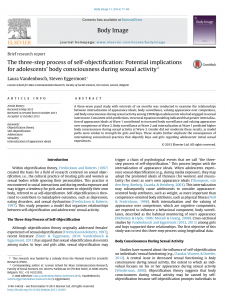Discrimination
The three-step process of self-objectification
 Full Article Name: The Three-Step Process of Self-Objectification: Potential Implications for Adolescents’ Body Consciousness during Sexual Activity
Full Article Name: The Three-Step Process of Self-Objectification: Potential Implications for Adolescents’ Body Consciousness during Sexual Activity
Open Access: Yes
Highlights
- • A longitudinal study among 238 adolescents was conducted.
- • Internalization of appearance ideals (Wave 1) predicted body surveillance (Wave 2).
- • Internalization (Wave 1) predicted self-objectification (Wave 2).
- • Body surveillance (Wave 2) predicted sexual body consciousness (Wave 3).
- • Gender did not moderate the results.
Abstract
A three-wave panel study with intervals of six months was conducted to examine the relationships between internalization of appearance ideals, body surveillance, valuing appearance over competence, and body consciousness during sexual activity among 238 Belgian adolescents who had engaged in sexual intercourse. Consistent with predictions, structural equation modeling indicated that greater internalization of appearance ideals at Wave 1 contributed to increased body surveillance and valuing appearance over competence at Wave 2. Body surveillance at Wave 2 and internalization at Wave 1 predicted higher body consciousness during sexual activity at Wave 3. Gender did not moderate these results, as model paths were similar in strength for girls and boys. These results further implicate the consequences of internalizing sociocultural practices that objectify boys and girls regarding adolescents’ initial sexual experiences.
Citation
Vandenbosch, L., & Eggermont, S. (2014). The three-step process of self-objectifcation: Potential
implications for adolescents’ body consciousness during sexual activity. Body Image, 11(1), 77–80. https://doi.org/10.1016/j.bodyim.2013.10.005

